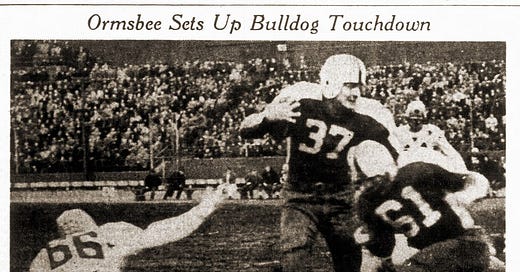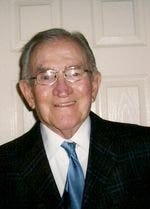MSL to NFL: Arrival of 'Bus' Ormsbee Was Big News 75 Years Ago
Became Head Football Coach at Arlington; First Athletic Director at Wheeling
It was big news when the “Bus” arrived to coach high school football in the Northwest suburbs and District 214.
No, it wasn’t “The Bus” you may be thinking of, ex-NFL running back Jerome Bettis. It didn’t garner the prolific amount of media attention that came with the news of Rolling Meadows hiring popular ex-Bears kicker Robbie Gould as its new head coach in February.
After all, TV was still a relatively newfangled thing not accessible to most Americans when Ezra Elliott “Bus” Ormsbee arrived at Arlington High School in the fall of 1949 to teach science and become an assistant football coach. But word and excitement quickly spread through the area about the new coach who played running back and defensive back with the Philadelphia Eagles.
Legendary Daily Herald prep columnist Bob Frisk was in eighth grade and hoped he might eventually carry the ball for Ormsbee at Arlington. Frisk wrote about how exciting it was in his May 1983 column titled, “After 34 Years, the Bus Stops Here for Ormsbee,” as he closed in on retirement as Wheeling’s athletic director.
“We couldn’t wait to meet this coach who had actually played professional football with the Philadelphia Eagles,” Frisk wrote, “and had worked in the same backfield with superstar Joe Perry (1969 Pro Football Hall of Fame inductee) of the San Francisco 49ers before an injury cut short a career.”
Frisk joked that Ormsbee’s honest analysis cut short his prep football career as a freshman and hastened his move to journalism. But they had an excellent rapport where Frisk wrote “we haven’t had a harsh word in 25 years of a coach-administrator-reporter relationship” during Ormsbee’s time as a football coach at Arlington and the first athletic director at Wheeling.
Ormsbee was an assistant to Curtis “Tego” Larsen for two years at Arlington before taking over the program for 12 years from 1951-62. His first team went winless in the school’s transition into the rugged West Suburban Conference. But Frisk regarded Ormsbee’s 1959 team led by quarterback George Bork and Mike Dundy one of the finest he covered as the Cardinals finished 6-2 overall and third in the WSC. Bork’s prolific passing led to a Hall of Fame career at Northern Illinois and a stint in the Canadian Football League (CFL) and Dundy played in the 1964 Rose Bowl for Illinois.
Ormsbee was named Wheeling’s athletic director late in 1963. He was instrumental in creating the successful Wildcat Hardwood Classic basketball tournament with head coach Ted Ecker and creating the Wheeling Wildcat Relays (now the Wildcat Invitational track and field indoor meet). He was a charter member of the Wheeling Athletic Hall of Fame in 2007 with Jack Bastable, Pat Ritchie, Dana Miroballi and John Petersen.
Ormsbee retired to Hot Springs Village, Ark., and passed away Dec. 11, 2010 at 89.
“Bus was very competitive and he expected that level of intensity from his coaches and student-athletes,” Ritchie, who was a coach and girls athletic director, told the Herald’s Eileen O. Daday after Ormsbee’s death. “He strived to be No. 1 in everything and everyone respected him for that.”
That competitiveness was forged in the small town of Hamilton, on the east side of the Mississippi River across from Keokuk, Iowa, where he was an all-state halfback and three-sport standout. Ormsbee got the nickname “Bus” from his dad calling him “Buster,” which his longtime Wheeling athletic secretary Evelyn Mendralla told Daday in 2010.
Ormsbee headed east to Peoria and Bradley University where he was a two-time Little All-American halfback in 1941 and 1942 and also lettered in baseball and basketball. He spent two years during World War II on a Naval submarine in the South Pacific.
Ormsbee was chosen for a different type of draft in 1944 when he was selected in the 11th round of the annual NFL event by the Eagles. Ormsbee got into 4 games in 1946 and rushed for 12 yards on 4 carries and had a kick return for 5 yards, according to Pro Football Reference.
In 1947, Ormsbee starred for the Eagles’ “farm” team of American Football League champion Bethlehem (Pa.). His statistics varied from different newspaper accounts, but Ormsbee led the AFL in touchdowns with 16, had around 600 yards rushing and 500 receiving, punted for a 39-yard average and had 4 interceptions. That led to his opportunity with the 49ers that was cut short by injury.
Ormsbee married his high school sweetheart Jeanne in 1948 and came to Arlington a year later. His son Terry also became an all-state quarterback at Arlington.
Another of his players on the 1959 team, Gene Dahlquist, had a long coaching career in Division I, NFL Europe and the CFL. Dahlquist alternated at quarterback with Bork as juniors but Ormsbee moved Dahlquist to receiver, where he became an all-WSC performer and went on to play at the University of Arizona.
“I couldn’t miss this for coach,” Dahlquist told Frisk of attending Ormsbee’s retirement dinner. “Bus has always meant a lot to me and I wanted to be a part of his evening.”
Ormsbee’s legacy continues in District 214 as he was one of the key figures in developing the Howard Lester awards given annually to one male and one female senior athlete. Ormsbee, Arlington’s Russ Attis and Prospect’s George Gattas comprised the main committee that helped set the criteria for the awards honoring Lester’s 42 years in education and development of many programs in the district before he passed away in 1981.
“Howard was a very special person to this district,” Ormsbee told Frisk in May 1983. “And the student-athlete concept was so important to him.”
The same could be said for the Bus stop that captivated the area 75 years ago.






Bus Ormsbee was my grandpa. Thank you for writing this. It meant a lot.